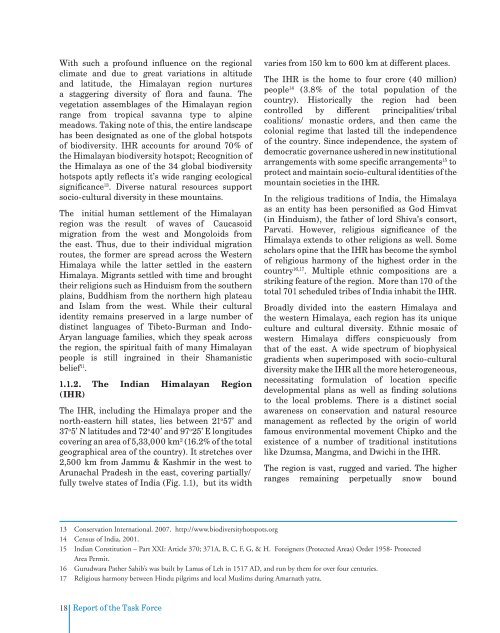Task Force Report - Govind Ballabh Pant Institute of Himalayan ...
Task Force Report - Govind Ballabh Pant Institute of Himalayan ...
Task Force Report - Govind Ballabh Pant Institute of Himalayan ...
You also want an ePaper? Increase the reach of your titles
YUMPU automatically turns print PDFs into web optimized ePapers that Google loves.
With such a pr<strong>of</strong>ound influence on the regional<br />
climate and due to great variations in altitude<br />
and latitude, the <strong>Himalayan</strong> region nurtures<br />
a staggering diversity <strong>of</strong> flora and fauna. The<br />
vegetation assemblages <strong>of</strong> the <strong>Himalayan</strong> region<br />
range from tropical savanna type to alpine<br />
meadows. Taking note <strong>of</strong> this, the entire landscape<br />
has been designated as one <strong>of</strong> the global hotspots<br />
<strong>of</strong> biodiversity. IHR accounts for around 70% <strong>of</strong><br />
the <strong>Himalayan</strong> biodiversity hotspot; Recognition <strong>of</strong><br />
the Himalaya as one <strong>of</strong> the 34 global biodiversity<br />
hotspots aptly reflects it’s wide ranging ecological<br />
significance 13 . Diverse natural resources support<br />
socio-cultural diversity in these mountains.<br />
The initial human settlement <strong>of</strong> the <strong>Himalayan</strong><br />
region was the result <strong>of</strong> waves <strong>of</strong> Caucasoid<br />
migration from the west and Mongoloids from<br />
the east. Thus, due to their individual migration<br />
routes, the former are spread across the Western<br />
Himalaya while the latter settled in the eastern<br />
Himalaya. Migrants settled with time and brought<br />
their religions such as Hinduism from the southern<br />
plains, Buddhism from the northern high plateau<br />
and Islam from the west. While their cultural<br />
identity remains preserved in a large number <strong>of</strong><br />
distinct languages <strong>of</strong> Tibeto-Burman and Indo-<br />
Aryan language families, which they speak across<br />
the region, the spiritual faith <strong>of</strong> many <strong>Himalayan</strong><br />
people is still ingrained in their Shamanistic<br />
belief 11 .<br />
1.1.2. The Indian <strong>Himalayan</strong> Region<br />
(IHR)<br />
The IHR, including the Himalaya proper and the<br />
north-eastern hill states, lies between 21 o 57’ and<br />
37 o 5’ N latitudes and 72 o 40’ and 97 o 25’ E longitudes<br />
covering an area <strong>of</strong> 5,33,000 km 2 (16.2% <strong>of</strong> the total<br />
geographical area <strong>of</strong> the country). It stretches over<br />
2,500 km from Jammu & Kashmir in the west to<br />
Arunachal Pradesh in the east, covering partially/<br />
fully twelve states <strong>of</strong> India (Fig. 1.1), but its width<br />
varies from 150 km to 600 km at different places.<br />
The IHR is the home to four crore (40 million)<br />
people 14 (3.8% <strong>of</strong> the total population <strong>of</strong> the<br />
country). Historically the region had been<br />
controlled by different principalities/tribal<br />
coalitions/ monastic orders, and then came the<br />
colonial regime that lasted till the independence<br />
<strong>of</strong> the country. Since independence, the system <strong>of</strong><br />
democratic governance ushered in new institutional<br />
arrangements with some specific arrangements 15 to<br />
protect and maintain socio-cultural identities <strong>of</strong> the<br />
mountain societies in the IHR.<br />
In the religious traditions <strong>of</strong> India, the Himalaya<br />
as an entity has been personified as God Himvat<br />
(in Hinduism), the father <strong>of</strong> lord Shiva’s consort,<br />
Parvati. However, religious significance <strong>of</strong> the<br />
Himalaya extends to other religions as well. Some<br />
scholars opine that the IHR has become the symbol<br />
<strong>of</strong> religious harmony <strong>of</strong> the highest order in the<br />
country 16,17 . Multiple ethnic compositions are a<br />
striking feature <strong>of</strong> the region. More than 170 <strong>of</strong> the<br />
total 701 scheduled tribes <strong>of</strong> India inhabit the IHR.<br />
Broadly divided into the eastern Himalaya and<br />
the western Himalaya, each region has its unique<br />
culture and cultural diversity. Ethnic mosaic <strong>of</strong><br />
western Himalaya differs conspicuously from<br />
that <strong>of</strong> the east. A wide spectrum <strong>of</strong> biophysical<br />
gradients when superimposed with socio-cultural<br />
diversity make the IHR all the more heterogeneous,<br />
necessitating formulation <strong>of</strong> location specific<br />
developmental plans as well as finding solutions<br />
to the local problems. There is a distinct social<br />
awareness on conservation and natural resource<br />
management as reflected by the origin <strong>of</strong> world<br />
famous environmental movement Chipko and the<br />
existence <strong>of</strong> a number <strong>of</strong> traditional institutions<br />
like Dzumsa, Mangma, and Dwichi in the IHR.<br />
The region is vast, rugged and varied. The higher<br />
ranges remaining perpetually snow bound<br />
13 Conservation International. 2007. http://www.biodiversityhotspots.org<br />
14 Census <strong>of</strong> India, 2001.<br />
15 Indian Constitution – Part XXI: Article 370; 371A, B, C, F, G, & H. Foreigners (Protected Areas) Order 1958- Protected<br />
Area Permit.<br />
16 Gurudwara Pather Sahib’s was built by Lamas <strong>of</strong> Leh in 1517 AD, and run by them for over four centuries.<br />
17 Religious harmony between Hindu pilgrims and local Muslims during Amarnath yatra.<br />
18<br />
<strong>Report</strong> <strong>of</strong> the <strong>Task</strong> <strong>Force</strong>

















